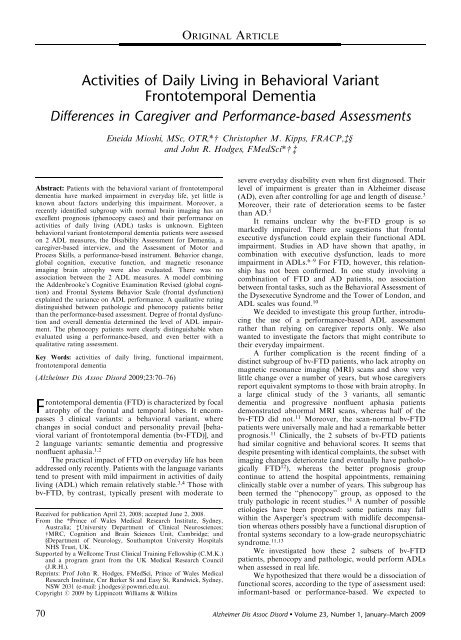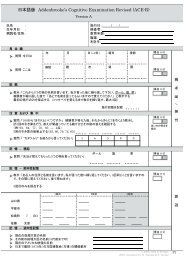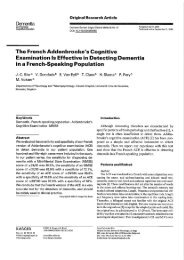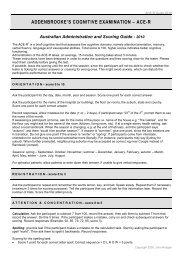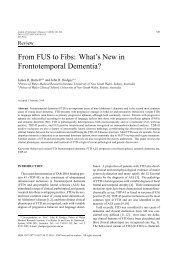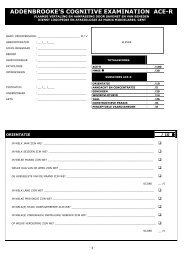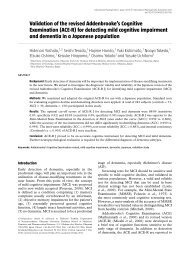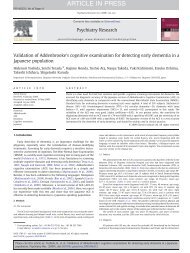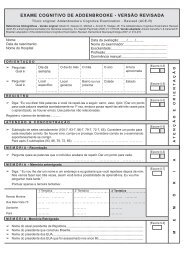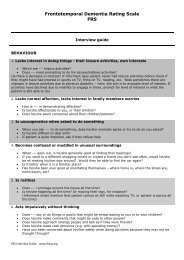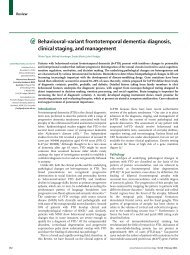Activities of Daily Living in Behavioral Variant Frontotemporal ...
Activities of Daily Living in Behavioral Variant Frontotemporal ...
Activities of Daily Living in Behavioral Variant Frontotemporal ...
You also want an ePaper? Increase the reach of your titles
YUMPU automatically turns print PDFs into web optimized ePapers that Google loves.
<strong>Activities</strong> <strong>of</strong> <strong>Daily</strong> <strong>Liv<strong>in</strong>g</strong> <strong>in</strong> <strong>Behavioral</strong> <strong>Variant</strong><br />
<strong>Frontotemporal</strong> Dementia<br />
Differences <strong>in</strong> Caregiver and Performance-based Assessments<br />
Eneida Mioshi, MSc, OTR,*w Christopher M. Kipps, FRACP,zy<br />
and John R. Hodges, FMedSci*w z<br />
Abstract: Patients with the behavioral variant <strong>of</strong> frontotemporal<br />
dementia have marked impairment <strong>in</strong> everyday life, yet little is<br />
known about factors underly<strong>in</strong>g this impairment. Moreover, a<br />
recently identified subgroup with normal bra<strong>in</strong> imag<strong>in</strong>g has an<br />
excellent prognosis (phenocopy cases) and their performance on<br />
activities <strong>of</strong> daily liv<strong>in</strong>g (ADL) tasks is unknown. Eighteen<br />
behavioral variant frontotemporal dementia patients were assessed<br />
on 2 ADL measures, the Disability Assessment for Dementia, a<br />
caregiver-based <strong>in</strong>terview, and the Assessment <strong>of</strong> Motor and<br />
Process Skills, a performance-based <strong>in</strong>strument. Behavior change,<br />
global cognition, executive function, and magnetic resonance<br />
imag<strong>in</strong>g bra<strong>in</strong> atrophy were also evaluated. There was no<br />
association between the 2 ADL measures. A model comb<strong>in</strong><strong>in</strong>g<br />
the Addenbrooke’s Cognitive Exam<strong>in</strong>ation Revised (global cognition)<br />
and Frontal Systems Behavior Scale (frontal dysfunction)<br />
expla<strong>in</strong>ed the variance on ADL performance. A qualitative rat<strong>in</strong>g<br />
dist<strong>in</strong>guished between pathologic and phenocopy patients better<br />
than the performance-based assessment. Degree <strong>of</strong> frontal dysfunction<br />
and overall dementia determ<strong>in</strong>ed the level <strong>of</strong> ADL impairment.<br />
The phenocopy patients were clearly dist<strong>in</strong>guishable when<br />
evaluated us<strong>in</strong>g a performance-based, and even better with a<br />
qualitative rat<strong>in</strong>g assessment.<br />
Key Words: activities <strong>of</strong> daily liv<strong>in</strong>g, functional impairment,<br />
frontotemporal dementia<br />
(Alzheimer Dis Assoc Disord 2009;23:70–76)<br />
<strong>Frontotemporal</strong> dementia (FTD) is characterized by focal<br />
atrophy <strong>of</strong> the frontal and temporal lobes. It encompasses<br />
3 cl<strong>in</strong>ical variants: a behavioral variant, where<br />
changes <strong>in</strong> social conduct and personality prevail [behavioral<br />
variant <strong>of</strong> frontotemporal dementia (bv-FTD)], and<br />
2 language variants: semantic dementia and progressive<br />
nonfluent aphasia. 1,2<br />
The practical impact <strong>of</strong> FTD on everyday life has been<br />
addressed only recently. Patients with the language variants<br />
tend to present with mild impairment <strong>in</strong> activities <strong>of</strong> daily<br />
liv<strong>in</strong>g (ADL) which rema<strong>in</strong> relatively stable. 3,4 Those with<br />
bv-FTD, by contrast, typically present with moderate to<br />
Received for publication April 23, 2008; accepted June 2, 2008.<br />
From the *Pr<strong>in</strong>ce <strong>of</strong> Wales Medical Research Institute, Sydney,<br />
Australia; zUniversity Department <strong>of</strong> Cl<strong>in</strong>ical Neurosciences;<br />
wMRC, Cognition and Bra<strong>in</strong> Sciences Unit, Cambridge; and<br />
yDepartment <strong>of</strong> Neurology, Southampton University Hospitals<br />
NHS Trust, UK.<br />
Supported by a Wellcome Trust Cl<strong>in</strong>ical Tra<strong>in</strong><strong>in</strong>g Fellowship (C.M.K.)<br />
and a program grant from the UK Medical Research Council<br />
(J.R.H.).<br />
Repr<strong>in</strong>ts: Pr<strong>of</strong> John R. Hodges, FMedSci, Pr<strong>in</strong>ce <strong>of</strong> Wales Medical<br />
Research Institute, Cnr Barker St and Easy St, Randwick, Sydney,<br />
NSW 2031 (e-mail: j.hodges@powmri.edu.au).<br />
Copyright r 2009 by Lipp<strong>in</strong>cott Williams & Wilk<strong>in</strong>s<br />
ORIGINAL ARTICLE<br />
severe everyday disability even when first diagnosed. Their<br />
level <strong>of</strong> impairment is greater than <strong>in</strong> Alzheimer disease<br />
(AD), even after controll<strong>in</strong>g for age and length <strong>of</strong> disease. 3<br />
Moreover, their rate <strong>of</strong> deterioration seems to be faster<br />
than AD. 5<br />
It rema<strong>in</strong>s unclear why the bv-FTD group is so<br />
markedly impaired. There are suggestions that frontal<br />
executive dysfunction could expla<strong>in</strong> their functional ADL<br />
impairment. Studies <strong>in</strong> AD have shown that apathy, <strong>in</strong><br />
comb<strong>in</strong>ation with executive dysfunction, leads to more<br />
impairment <strong>in</strong> ADLs. 6–9 For FTD, however, this relationship<br />
has not been confirmed. In one study <strong>in</strong>volv<strong>in</strong>g a<br />
comb<strong>in</strong>ation <strong>of</strong> FTD and AD patients, no association<br />
between frontal tasks, such as the <strong>Behavioral</strong> Assessment <strong>of</strong><br />
the Dysexecutive Syndrome and the Tower <strong>of</strong> London, and<br />
ADL scales was found. 10<br />
We decided to <strong>in</strong>vestigate this group further, <strong>in</strong>troduc<strong>in</strong>g<br />
the use <strong>of</strong> a performance-based ADL assessment<br />
rather than rely<strong>in</strong>g on caregiver reports only. We also<br />
wanted to <strong>in</strong>vestigate the factors that might contribute to<br />
their everyday impairment.<br />
A further complication is the recent f<strong>in</strong>d<strong>in</strong>g <strong>of</strong> a<br />
dist<strong>in</strong>ct subgroup <strong>of</strong> bv-FTD patients, who lack atrophy on<br />
magnetic resonance imag<strong>in</strong>g (MRI) scans and show very<br />
little change over a number <strong>of</strong> years, but whose caregivers<br />
report equivalent symptoms to those with bra<strong>in</strong> atrophy. In<br />
a large cl<strong>in</strong>ical study <strong>of</strong> the 3 variants, all semantic<br />
dementia and progressive nonfluent aphasia patients<br />
demonstrated abnormal MRI scans, whereas half <strong>of</strong> the<br />
bv-FTD did not. 11 Moreover, the scan-normal bv-FTD<br />
patients were universally male and had a remarkable better<br />
prognosis. 11 Cl<strong>in</strong>ically, the 2 subsets <strong>of</strong> bv-FTD patients<br />
had similar cognitive and behavioral scores. It seems that<br />
despite present<strong>in</strong>g with identical compla<strong>in</strong>ts, the subset with<br />
imag<strong>in</strong>g changes deteriorate (and eventually have pathologically<br />
FTD 12 ), whereas the better prognosis group<br />
cont<strong>in</strong>ue to attend the hospital appo<strong>in</strong>tments, rema<strong>in</strong><strong>in</strong>g<br />
cl<strong>in</strong>ically stable over a number <strong>of</strong> years. This subgroup has<br />
been termed the ‘‘phenocopy’’ group, as opposed to the<br />
truly pathologic <strong>in</strong> recent studies. 11 A number <strong>of</strong> possible<br />
etiologies have been proposed: some patients may fall<br />
with<strong>in</strong> the Asperger’s spectrum with midlife decompensation<br />
whereas others possibly have a functional disruption <strong>of</strong><br />
frontal systems secondary to a low-grade neuropsychiatric<br />
syndrome. 11,13<br />
We <strong>in</strong>vestigated how these 2 subsets <strong>of</strong> bv-FTD<br />
patients, phenocopy and pathologic, would perform ADLs<br />
when assessed <strong>in</strong> real life.<br />
We hypothesized that there would be a dissociation <strong>of</strong><br />
functional scores, accord<strong>in</strong>g to the type <strong>of</strong> assessment used:<br />
<strong>in</strong>formant-based or performance-based. We expected to<br />
70 Alzheimer Dis Assoc Disord Volume 23, Number 1, January–March 2009
Alzheimer Dis Assoc Disord Volume 23, Number 1, January–March 2009 <strong>Activities</strong> <strong>of</strong> <strong>Daily</strong> <strong>Liv<strong>in</strong>g</strong> <strong>in</strong> bv-FTD<br />
f<strong>in</strong>d greater discrepancy <strong>of</strong> ADL scores <strong>in</strong> the phenocopy<br />
subgroup, that is, more impairment on the caregiver-based<br />
assessment.<br />
METHODS<br />
Participants<br />
Participants were recruited from the Early Dementia<br />
Onset cl<strong>in</strong>ic at Addenbrooke’s Hospital, Cambridge, UK.<br />
They were <strong>in</strong>cluded if they: (1) had a family member or<br />
caregiver, who could reliably give answers regard<strong>in</strong>g the<br />
patient’s rout<strong>in</strong>e and behavior; (2) had undergone<br />
a structural MRI scan with<strong>in</strong> 12 months <strong>of</strong> the ADL<br />
assessment; (3) had undergone an Addenbrooke’s Cognitive<br />
Exam<strong>in</strong>ation Revised (ACE-R) and tests <strong>of</strong> executive<br />
function (see below) with<strong>in</strong> 90 days <strong>of</strong> ADL assessments.<br />
Eight patients were not <strong>in</strong>cluded <strong>in</strong> the study because <strong>of</strong><br />
either (1) a physical impairment that could potentially<br />
confound assessment <strong>of</strong> ADLs; (2) evidence <strong>of</strong> major<br />
depression; or (3) evidence <strong>of</strong> significant cerebrovascular<br />
disease (<strong>in</strong>farcts or confluent white matter changes).<br />
Eighteen patients fulfilled criteria, 10 phenocopy and 8<br />
pathologic patients. Both groups met cl<strong>in</strong>ical criteria for<br />
bv-FTD, 2 but the phenocopy subgroup had no evidence <strong>of</strong><br />
atrophy on their MRI at presentation as evaluated by a<br />
validated semiquantitative visual rat<strong>in</strong>g scale 14 and showed<br />
no progression (no change on ACE-R scores, nor evidence<br />
<strong>of</strong> cl<strong>in</strong>ical deterioration) over at least 2 years <strong>of</strong> follow-up. 11<br />
These MRI rat<strong>in</strong>gs were used <strong>in</strong> comb<strong>in</strong>ation with cl<strong>in</strong>ical<br />
review <strong>of</strong> both neurologists (C.M.K. and J.R.H.) and were<br />
used as a gold standard to separate phenocopy and<br />
pathologic cases. The 2 raters were unanimous <strong>in</strong> their<br />
classification <strong>of</strong> cases. The occupational therapist (E.M.)<br />
who visited and performed both caregiver and patientbased<br />
assessments was bl<strong>in</strong>d to their status as pathologic or<br />
phenocopy cases dur<strong>in</strong>g the home visits.<br />
Instruments<br />
Brief Cognitive Assessment (ACE-R) and<br />
Neuropsychologic Executive Tests<br />
The ACE-R is designed to assess 5 cognitive doma<strong>in</strong>s,<br />
and has been shown to be sensitive to early stages <strong>of</strong><br />
dementia. Recommended cut-<strong>of</strong>fs are 88 and 82, with<br />
variable sensitivity and specificity for dementia. 15 One<br />
patient was unable to complete the ACE-R (n = 17).<br />
Patients were given the follow<strong>in</strong>g tests <strong>of</strong> executive<br />
function: the Trail Mak<strong>in</strong>g Test B, 16 the Key Search and<br />
the Zoo Map from the <strong>Behavioral</strong> Assessment <strong>of</strong> the<br />
Dysexecutive Syndrome. 17 Two patients could not perform<br />
the executive tasks (n = 16).<br />
<strong>Behavioral</strong> Change<br />
Patients were assessed on the Cambridge <strong>Behavioral</strong><br />
Inventory (CBI), 18,19 a caregiver-based questionnaire. Items<br />
are scored accord<strong>in</strong>g to frequency (0 to 4), with higher<br />
scores represent<strong>in</strong>g higher frequency <strong>of</strong> abnormal behavior.<br />
The CBI has been validated aga<strong>in</strong>st the neuropsychiatry<br />
<strong>in</strong>ventory and shown to discrim<strong>in</strong>ate between dementia<br />
syndromes.<br />
Frontal Assessment<br />
The Frontal Systems Behavior Scale (FrSBe), 20<br />
assesses frontal dysfunction (dis<strong>in</strong>hibition, apathy, and<br />
executive dysfunction) and it compares the patient’s status<br />
before and after diagnosis. Scores above cut-<strong>of</strong>f denote<br />
impairment. There is a caregiver and a self-reported version<br />
<strong>of</strong> the test. For the data analyses, we concentrated on scores<br />
from the ‘‘after illness’’ subtotal.<br />
Visual MRI Rat<strong>in</strong>g Scale<br />
The MRI rat<strong>in</strong>g scale is a visually based semiquantitative<br />
schedule that assesses atrophy <strong>in</strong> the frontal, anterior<br />
temporal, and posterior temporal bra<strong>in</strong> regions. Each<br />
region receives a score from 0 to 4; scores <strong>of</strong> 0 and<br />
1 are considered with<strong>in</strong> the normal range; 2, 3, and<br />
4 correspond to mild, moderate, and severe atrophy. 14 We<br />
also generated a total score <strong>of</strong> atrophy by add<strong>in</strong>g up all<br />
regions together, where greater scores denote greater<br />
atrophy <strong>in</strong> the frontal and temporal lobes (max score 16).<br />
Not all patients had MRI scans at the time <strong>of</strong> the home visit<br />
(n = 14); 2 refused to be scanned so their classification as<br />
phenocopy or pathologic was based on MRI scann<strong>in</strong>g<br />
before the time <strong>of</strong> the study. We did not <strong>in</strong>clude their<br />
rat<strong>in</strong>gs <strong>in</strong>to the analyses.<br />
ADL<br />
ADL ability was assessed with 2 different scales,<br />
a caregiver-based scale, the Disability Assessment <strong>of</strong><br />
Dementia (DAD) and a patient-based scale, the Assessment<br />
<strong>of</strong> Motor and Process Skills (AMPS).<br />
The DAD is an <strong>in</strong>formant-based scale. 21 It <strong>in</strong>cludes 40<br />
items—17 related to basic self-care (basic ADLs: ‘‘hygiene,’’<br />
‘‘dress<strong>in</strong>g,’’ ‘‘cont<strong>in</strong>ence,’’ and ‘‘eat<strong>in</strong>g’’) and 23<br />
related to <strong>in</strong>strumental activities <strong>of</strong> daily liv<strong>in</strong>g (‘‘meal<br />
preparation,’’ ‘‘telephon<strong>in</strong>g,’’ ‘‘go<strong>in</strong>g on an out<strong>in</strong>g,’’<br />
‘‘f<strong>in</strong>ance and correspondence,’’ ‘‘medications,’’ and ‘‘leisure<br />
and housework’’). Lower scores on the DAD denote greater<br />
impairment. The scale is designed to have its total score<br />
corrected to 100, that is, nonapplicable questions are<br />
excluded from the total score to avoid sex bias toward<br />
activities (eg, cook<strong>in</strong>g, house chores, f<strong>in</strong>ances).<br />
Patients were also assessed with the AMPS. The<br />
AMPS is a performance-based scale that has been used<br />
extensively. 22–25 The patient performs 2 everyday tasks<br />
from a set <strong>of</strong> 83 standardized tasks. The assessment<br />
simultaneously measures 16 motor (eg, coord<strong>in</strong>ation, grip,<br />
transportation, etc.) and 20 mental process skills (eg,<br />
search<strong>in</strong>g, choos<strong>in</strong>g, organiz<strong>in</strong>g, sequenc<strong>in</strong>g, etc.), and their<br />
effect on the ability <strong>of</strong> the person to perform familiar ADL<br />
tasks. Both tasks’ scores are used <strong>in</strong> conjunction for the<br />
AMPS score. Raw scores from each motor and process skill<br />
are converted <strong>in</strong>to logits, us<strong>in</strong>g a Rasch model approach. A<br />
s<strong>of</strong>tware program compares a patient score aga<strong>in</strong>st age and<br />
sex-matched controls; scores lower than cut-<strong>of</strong>fs denote<br />
impairment. For the analyses, we concentrated on the<br />
process component scores, as we expected normal scores on<br />
the motor component <strong>of</strong> the assessment.<br />
Qualitative Rat<strong>in</strong>g<br />
Once the occupational therapy (OT) started do<strong>in</strong>g the<br />
home visits, it became clear that the AMPS as a factor was<br />
unlikely to capture nuances <strong>of</strong> behavior demonstrated<br />
dur<strong>in</strong>g an extensive home assessment. Some patients were<br />
very good hosts dur<strong>in</strong>g the visit (organized their own<br />
appo<strong>in</strong>tments over the phone; made conversation dur<strong>in</strong>g<br />
the visit; <strong>of</strong>fered to make a cup <strong>of</strong> tea or c<strong>of</strong>fee; were keen to<br />
demonstrate their ADL abilities, etc.)—this appropriate<br />
behavior would not be captured by the ADL assessment.<br />
r 2009 Lipp<strong>in</strong>cott Williams & Wilk<strong>in</strong>s 71
Mioshi et al Alzheimer Dis Assoc Disord Volume 23, Number 1, January–March 2009<br />
TABLE 1. Mean Scores <strong>of</strong> bv-FTD Patients on ACE-R and Executive Tests (SD <strong>in</strong> Brackets)<br />
Cognitive Tests<br />
(Max Score)<br />
bv-FTD,<br />
n=18<br />
Other patients, however, produced stereotypical and even<br />
bizarre behaviors while the therapist was there, and this<br />
type <strong>of</strong> behavior is not traditionally rated <strong>in</strong>to performance-based<br />
assessments (eg, tell<strong>in</strong>g the OT he was go<strong>in</strong>g<br />
to show someth<strong>in</strong>g, then gett<strong>in</strong>g 2 spoons and bang<strong>in</strong>g them<br />
onto the door very loudly while giggl<strong>in</strong>g; count<strong>in</strong>g numbers<br />
aloud while prepar<strong>in</strong>g a sandwich; swear<strong>in</strong>g at the<br />
therapist).<br />
We decided, therefore, to <strong>in</strong>troduce a qualitative<br />
analysis <strong>of</strong> the whole home visit, which was based on<br />
grounded theory. 26 The ma<strong>in</strong> pr<strong>in</strong>cipal <strong>of</strong> this approach is<br />
the generation <strong>of</strong> a theory which is grounded on the data,<br />
especially actions, <strong>in</strong>teractions, and social processes. 27 To<br />
achieve this, the entire home visit was recorded <strong>in</strong> notes<br />
(note-tak<strong>in</strong>g); different types <strong>of</strong> behaviors were identified<br />
(cod<strong>in</strong>g) <strong>in</strong> all 18 visits, and the visit notes were reviewed<br />
several times (constant comparison) to create core behavior<br />
categories (core categories) us<strong>in</strong>g a reiterative method until<br />
saturation was reached. From these behavior categories, it<br />
became clear that some core behaviors could be grouped<br />
<strong>in</strong>to positive and others <strong>in</strong>to negative behaviors. The<br />
number <strong>of</strong> negative behaviors clearly surpassed the number<br />
<strong>of</strong> positive ones. Each patient was then rated <strong>in</strong> the whole<br />
list <strong>of</strong> behaviors, hav<strong>in</strong>g been assigned a score <strong>of</strong> 1<br />
bv-FTD<br />
Pathologic,<br />
n=8<br />
bv-FTD<br />
Phenocopy,<br />
n=10<br />
Phenocopy vs.<br />
Pathologic<br />
ACE-R (100) 77.9 (16.9) 65.4 (19.8) 86.6 (6.4) *<br />
Trails B, sec 212 (142.9) 305 (173) 143 (58) n.s.<br />
Zoo Map (4) 1.71 (1.3) 0.4 (0.5) 2.4 (1) *<br />
Key Search (4) 2.9 (1.1) 2.7 (0.8) 3 (1.3) n.s.<br />
CBI total (324) 103 (57.9) 104 (51.7) 102.3 (64.6) n.s.<br />
CBI apathy (32) 57.5 (24.4) 57.6 (15.9) 57.5 (29.9) n.s.<br />
*P
Alzheimer Dis Assoc Disord Volume 23, Number 1, January–March 2009 <strong>Activities</strong> <strong>of</strong> <strong>Daily</strong> <strong>Liv<strong>in</strong>g</strong> <strong>in</strong> bv-FTD<br />
TABLE 2. <strong>Activities</strong> <strong>of</strong> <strong>Daily</strong> <strong>Liv<strong>in</strong>g</strong> Mean Scores, Caregiver and Performance-based (SD <strong>in</strong> Brackets)<br />
bv-FTD bv-FTD<br />
bv-FTD, Pathology, Phenocopy, Phenocopy vs.<br />
ADL Assessments n=18<br />
n=8<br />
n=10 Pathology<br />
DAD (%) (0-100) 61 (27) 55 (30) 66 (24) n.s.<br />
AMPS process<br />
(cut-<strong>of</strong>f 0.78)<br />
1.05 (0.69) 0.7 (0.5) 1.4 (0.7) *<br />
AMPS motor<br />
(cut-<strong>of</strong>f 1.39)<br />
2.12 (0.62) 1.94 (0.68) 2.26 (0.56) n.s.<br />
Cut-<strong>of</strong>fs for AMPS process and AMPS motor are presented as a group mean.<br />
*P
Mioshi et al Alzheimer Dis Assoc Disord Volume 23, Number 1, January–March 2009<br />
Qualitative rat<strong>in</strong>g<br />
4<br />
3<br />
2<br />
1<br />
0<br />
-1<br />
-2<br />
-3<br />
-4<br />
RL AL RA WL PL RB ML AP NS JG MP JC MW KF PW SW AE CR<br />
model accounted for 60.4% <strong>of</strong> the variance <strong>of</strong> AMPS<br />
process scores (F 2,9 = 9.41, P = 0.006). Tolerance between<br />
variables was with<strong>in</strong> acceptable limits (Table 3).<br />
We also expected the process component <strong>of</strong> the AMPS<br />
to be able to discrim<strong>in</strong>ate well phenocopy from pathologic<br />
patients. On the discrim<strong>in</strong>ant analysis, the process component<br />
<strong>of</strong> the AMPS was very good at detect<strong>in</strong>g group<br />
classification, with 77.8% <strong>of</strong> group accuracy.<br />
Qualitative Rat<strong>in</strong>g<br />
As expla<strong>in</strong>ed <strong>in</strong> the method section, a qualitative<br />
rat<strong>in</strong>g derived from the grounded theory analysis was<br />
generated. This qualitative rat<strong>in</strong>g was applied <strong>in</strong> a<br />
discrim<strong>in</strong>ant analysis, reveal<strong>in</strong>g that it was excellent at<br />
dist<strong>in</strong>guish<strong>in</strong>g between phenocopy and pathologic cases<br />
(94.4%).<br />
Qualitative Rat<strong>in</strong>g and MRI Rat<strong>in</strong>g<br />
As shown on Figure 2, we explored the relationship<br />
between bra<strong>in</strong> atrophy and degree <strong>of</strong> qualitative behavioral<br />
change on a case-by-case basis by rank-order<strong>in</strong>g patients<br />
accord<strong>in</strong>g to their composite MRI rat<strong>in</strong>g. All but one <strong>of</strong> the<br />
phenocopy patients had a qualitative rat<strong>in</strong>g above zero,<br />
denot<strong>in</strong>g more positive behaviors than negative ones. By<br />
contrast, all pathologic patients had qualitative rat<strong>in</strong>gs<br />
below zero, denot<strong>in</strong>g the presence <strong>of</strong> more negative<br />
behaviors. A strong <strong>in</strong>verse correlation between qualitative<br />
scores and MRI rat<strong>in</strong>gs was found (r = 0.68, n = 18,<br />
P
Alzheimer Dis Assoc Disord Volume 23, Number 1, January–March 2009 <strong>Activities</strong> <strong>of</strong> <strong>Daily</strong> <strong>Liv<strong>in</strong>g</strong> <strong>in</strong> bv-FTD<br />
ADL task and <strong>in</strong> the social <strong>in</strong>teraction with the OT.<br />
It is also <strong>in</strong>terest<strong>in</strong>g to note that the number <strong>of</strong> more<br />
prom<strong>in</strong>ent negative behaviors <strong>in</strong> the pathologic patients<br />
might have a direct impact on their performance <strong>of</strong><br />
ADLs.<br />
It is not completely clear why there was a discrepancy<br />
between caregiver and performance-based assessments.<br />
Apathy could be one <strong>of</strong> the keys to the discrepancy<br />
between the 2 ADL measures, as pathologic patients<br />
showed prom<strong>in</strong>ent impairment on the AMPS and also on<br />
the FrSBe apathy, both caregiver and self-rat<strong>in</strong>g. Additional<br />
reasons could be that caregivers <strong>of</strong> phenocopy<br />
patients overestimate the degree <strong>of</strong> impairment. Patients<br />
may have adopted a ‘‘sick role,’’ which is then selfperpetuat<strong>in</strong>g;<br />
even though they are capable <strong>of</strong> perform<strong>in</strong>g<br />
the activities, they no longer undertake them at home.<br />
Alternatively, they manage to demonstrate <strong>in</strong>tact abilities <strong>in</strong><br />
the constra<strong>in</strong>ts <strong>of</strong> a formal evaluation but not on an<br />
everyday basis. If the latter, then our results suggest a<br />
different substrate underly<strong>in</strong>g functional impairment <strong>in</strong><br />
phenocopy patients.<br />
Our results corroborate previous f<strong>in</strong>d<strong>in</strong>gs 11,13 <strong>of</strong> a<br />
dist<strong>in</strong>ct benign subgroup <strong>of</strong> bv-FTD patients, which is<br />
characterized by normal MRI scans, marked changes <strong>in</strong><br />
behavior, and carer-reported changes <strong>in</strong> ADL function<strong>in</strong>g<br />
(as seen <strong>in</strong> the pathologic subgroup), but better neuropsychologic<br />
test results and normal ADL abilities when<br />
evaluated on performance-based assessments. The phenocopy<br />
patients are clearly dist<strong>in</strong>ct from the pathologic<br />
group <strong>in</strong> the qualitative rat<strong>in</strong>g, and do not deteriorate<br />
with time.<br />
A full discussion <strong>of</strong> the etiology <strong>of</strong> the phenocopy<br />
cases is beyond the scope <strong>of</strong> this article. A proportion<br />
<strong>of</strong> patients probably have long-stand<strong>in</strong>g personality disorders<br />
with<strong>in</strong> the Asperger spectrum, which has decompensated<br />
<strong>in</strong> midlife whereas others may have a<br />
neuropsychiatric disorder (for fuller discussion see Davies<br />
et al 13 and Kipps et al 11,28 ). Justification for regard<strong>in</strong>g the<br />
pathologic cases as hav<strong>in</strong>g true FTD is strong. Although<br />
none <strong>of</strong> the participants <strong>in</strong> the current study have died,<br />
we have followed similar patients who presented to the<br />
Cambridge cl<strong>in</strong>ic <strong>in</strong> the 1990s for many years and<br />
achieved a very high rate <strong>of</strong> consent to postmortem study.<br />
Of those patients with the cl<strong>in</strong>ical syndrome <strong>of</strong> bv-FTD,<br />
bra<strong>in</strong> atrophy on MRI and clear progression to full-blown<br />
dementia, all had neurodegenerative disease with most<br />
fall<strong>in</strong>g with<strong>in</strong> the FTD spectrum: <strong>in</strong> the recent series <strong>of</strong><br />
100 patients with a focal cortical dementia, 28 met criteria<br />
for bv-FTD <strong>of</strong> whom 26 had 1 <strong>of</strong> the forms <strong>of</strong> FTD<br />
(tau-positive or ubiquit<strong>in</strong>-positive tau-negative <strong>in</strong>clusion<br />
pathology) and 2 had AD. 29<br />
The ratio <strong>of</strong> patients <strong>in</strong> the current study should not be<br />
taken to represent their <strong>in</strong>cidence. Phenocopy patients, by<br />
the nature <strong>of</strong> their benign prognosis, cont<strong>in</strong>ue to attend<br />
cl<strong>in</strong>ics and may become, therefore, over represented <strong>in</strong><br />
studies.<br />
To the best <strong>of</strong> our knowledge, this is the first study<br />
that evaluates bv-FTD patients <strong>in</strong> everyday life us<strong>in</strong>g<br />
a performance-based measure and that attempts to compare<br />
caregiver-based with performance-based measures. In<br />
addition, it is the first study to address underly<strong>in</strong>g cognitive<br />
and behavior factors that might expla<strong>in</strong> the severe<br />
impairment bv-FTD patients suffer <strong>in</strong> everyday life. It<br />
would have been even better to have longitud<strong>in</strong>al ADL<br />
performance-based assessment on these patients. Studies<br />
<strong>in</strong>volv<strong>in</strong>g a larger number <strong>of</strong> patients are clearly important<br />
to replicate our f<strong>in</strong>d<strong>in</strong>gs.<br />
The existence <strong>of</strong> a phenocopy subgroup <strong>in</strong> bv-FTD<br />
deserves cl<strong>in</strong>ical and research attention, and should be<br />
<strong>in</strong>vestigated further. A clear diagnosis <strong>of</strong> bv-FTD has<br />
strong associations with prognosis and <strong>in</strong>tervention, for<br />
both patients and caregivers. It is extremely difficult for<br />
families to accept a diagnosis <strong>of</strong> dementia and to manage its<br />
implications, but hav<strong>in</strong>g to deal with the removal <strong>of</strong> this<br />
label due to absence <strong>of</strong> deterioration is equally or even<br />
more challeng<strong>in</strong>g.<br />
REFERENCES<br />
1. Hodges JR. <strong>Frontotemporal</strong> dementia (Pick’s disease): cl<strong>in</strong>ical<br />
features and assessment. Neurology. 2001;56:S6–S10.<br />
2. Neary D, Snowden JS, Gustafson L, et al. <strong>Frontotemporal</strong><br />
lobar degeneration: a consensus on cl<strong>in</strong>ical diagnostic criteria.<br />
Neurology. 1998;51:1546–1554.<br />
3. Mioshi E, Kipps CM, Dawson K, et al. <strong>Activities</strong> <strong>of</strong> daily<br />
liv<strong>in</strong>g <strong>in</strong> frontotemporal dementia and Alzheimer disease.<br />
Neurology. 2007;68:2077–2084.<br />
4. Wicklund AH, Johnson N, Rademaker A, et al. Pr<strong>of</strong>iles <strong>of</strong><br />
decl<strong>in</strong>e <strong>in</strong> activities <strong>of</strong> daily liv<strong>in</strong>g <strong>in</strong> non-Alzheimer dementia.<br />
Alzheimer Dis Assoc Disord. 2007;21:8–13.<br />
5. Rascovsky K, Salmon DP, Lipton AM, et al. Rate <strong>of</strong><br />
progression differs <strong>in</strong> frontotemporal dementia and Alzheimer<br />
disease. Neurology. 2005;65:397–403.<br />
6. Chen ST, Sultzer DL, H<strong>in</strong>k<strong>in</strong> CH, et al. Executive dysfunction<br />
<strong>in</strong> Alzheimer’s disease: association with neuropsychiatric<br />
symptoms and functional impairment. J Neuropsychiatry Cl<strong>in</strong><br />
Neurosci. 1998;10:426–432.<br />
7. Stout JC, Wyman MF, Johnson SA, et al. Frontal behavioral<br />
syndromes and functional status <strong>in</strong> probable Alzheimer<br />
disease. Am J Geriatr Psychiatry. 2003;11:683–686.<br />
8. Boyle PA, Malloy PF, Salloway S, et al. Executive dysfunction<br />
and apathy predict functional impairment <strong>in</strong> Alzheimer<br />
disease. Am J Geriatr Psychiatry. 2003;11:214–221.<br />
9. Norton LE, Malloy PF, Salloway S. The impact <strong>of</strong> behavioral<br />
symptoms on activities <strong>of</strong> daily liv<strong>in</strong>g <strong>in</strong> patients with<br />
dementia. Am J Geriatr Psychiatry. 2001;9:41–48.<br />
10. Piquard A, Derouesne C, Lacomblez L, et al. Plann<strong>in</strong>g and<br />
activities <strong>of</strong> daily liv<strong>in</strong>g <strong>in</strong> Alzheimer’s disease and frontotemporal<br />
dementia. Psychol Neuropsychiatr Vieil. 2004;2:147–156.<br />
11. Kipps CM, Nestor PJ, Fryer TD, et al. Behavioural variant<br />
frontotemporal dementia: not all it seems? Neurocase.<br />
2007;13:237–247.<br />
12. Hodges JR, Davies RR, Xuereb JH, et al. Cl<strong>in</strong>icopathological<br />
correlates <strong>in</strong> frontotemporal dementia. Ann Neurol. 2004;56:<br />
399–406.<br />
13. Davies RR, Kipps CM, Mitchell J, et al. Progression <strong>in</strong><br />
frontotemporal dementia: identify<strong>in</strong>g a benign behavioral<br />
variant by magnetic resonance imag<strong>in</strong>g. Arch Neurol.<br />
2006;63:1627–1631.<br />
14. Broe M, Hodges JR, Sch<strong>of</strong>ield E, et al. Stag<strong>in</strong>g disease severity<br />
<strong>in</strong> pathologically confirmed cases <strong>of</strong> frontotemporal dementia.<br />
Neurology. 2003;60:1005–1011.<br />
15. Mioshi E, Dawson K, Mitchell J, et al. The Addenbrooke’s<br />
Cognitive Exam<strong>in</strong>ation Revised (ACE-R): a brief cognitive test<br />
battery for dementia screen<strong>in</strong>g. Int J Geriatr Psychiatry.<br />
2006;21:1078–1085.<br />
16. Reitan RM, Wolfson D. Category Test and Trail Mak<strong>in</strong>g Test<br />
as measures <strong>of</strong> frontal lobe functions. Cl<strong>in</strong> Neuropsychol.<br />
1995;19:281–288.<br />
17. Wilson BA, Alderman N, Burgess PW, et al. Behavioural<br />
Assessment <strong>of</strong> the Dysexecutive Syndrome-BADS. Bury St<br />
Edmunds, England: Thames Valley Test Company; 1996.<br />
18. Nagahama Y, Ok<strong>in</strong>a T, Suzuki N, et al. The Cambridge<br />
<strong>Behavioral</strong> Inventory: validation and application <strong>in</strong> a<br />
memory cl<strong>in</strong>ic. J Geriatr Psychiatry Neurol. 2006;19:<br />
220–225.<br />
r 2009 Lipp<strong>in</strong>cott Williams & Wilk<strong>in</strong>s 75
Mioshi et al Alzheimer Dis Assoc Disord Volume 23, Number 1, January–March 2009<br />
19. Wedderburn C, Wear H, Brown J, et al. The utility <strong>of</strong> the<br />
Cambridge Behavioural Inventory <strong>in</strong> neurodegenerative<br />
disease. J Neurol Neurosurg Psychiatry. 2008;79:500–503.<br />
20. Grace J, Malloy PF. Frontal Systems Behaviour Scale. Lutz,<br />
FL: Psychological Assessment Resources; 2001.<br />
21. Gel<strong>in</strong>as I, Gauthier L, McIntyre M, et al. Development <strong>of</strong> a<br />
functional measure for persons with Alzheimer’s disease: the<br />
disability assessment for dementia. Am J Occup Ther. 1999;53:<br />
471–481.<br />
22. Doble SE, Fisk JD, MacPherson KM, et al. Measur<strong>in</strong>g<br />
functional competence <strong>in</strong> older persons with Alzheimer’s<br />
disease. Int Psychogeriatr. 1997;9:25–38.<br />
23. Doble SE, Fisk JD, Rockwood K. Assess<strong>in</strong>g the ADL<br />
function<strong>in</strong>g <strong>of</strong> persons with Alzheimer’s disease: comparison<br />
<strong>of</strong> family <strong>in</strong>formants’ rat<strong>in</strong>gs and performance-based assessment<br />
f<strong>in</strong>d<strong>in</strong>gs. Int Psychogeriatr. 1999;11:399–409.<br />
24. Rob<strong>in</strong>son SE, Fisher AG. Functional and cognitive differences<br />
between cognitively-well people and people with dementia.<br />
Br J Occup Ther. 1999;62:466–471.<br />
25. Hartman ML, Fisher AG, Duran L. Assessment <strong>of</strong> functional<br />
ability <strong>of</strong> people with Alzheimer’s Disease. Scand J Occup Ther.<br />
1999;6:111–118.<br />
26. Glaser BG, Strauss A. Discovery <strong>of</strong> Grounded Theory. Strategies<br />
for Qualitative Research. Mill Valley, CA: Sociology Press; 1967.<br />
27. Creswell J. Qualitative Inquiry and Research Design-choos<strong>in</strong>g<br />
Among Five Traditions. Thousand Oaks, CA: Sage Publications;<br />
1997.<br />
28. Kipps CM, Nestor PJ, Dawson CE, et al. Measur<strong>in</strong>g<br />
progression <strong>in</strong> frontotemporal dementia: implications for<br />
therapeutic <strong>in</strong>terventions. Neurology. 2008;70:2046–2052.<br />
29. Alladi S, Xuereb J, Bak T, et al. Focal cortical presentations <strong>of</strong><br />
Alzheimer’s disease. Bra<strong>in</strong>. 2007;130:2636–2645.<br />
76 r 2009 Lipp<strong>in</strong>cott Williams & Wilk<strong>in</strong>s


